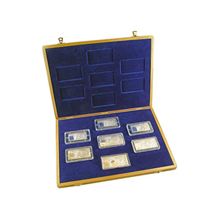2003 soubor pamětních mincí s motivy slovenských bankovek

SPECIFIKACE
Pamětní stříbrná mince v hodnotě 5000, 1000, 500, 200, 100, 50 a 20 Sk
Autor: přepisu Štefan Novotný, Mária Poldaufová
Nominál Rozměry(mm) Hmotnost Ag(g) Hmotnost Au(g) Hmotnost mince(g)
20 Sk 27,1 x 50,6 24,48 - 24,48
50 Sk 28,2 x 52,8 26,63 - 26,63
100 Sk 29,3 x 55,0 28,87 - 28,87
200 Sk 30,4 x 57,2 31,21 - 31,21
500 Sk 31,5 x 59,4 33,63 - 33,63
1000 Sk 32,6 x 61,6 43,91 0,280 44,190
5000 Sk 33,4 x 63,8 46,65 0,594 a 0,370 47,614
hrana hladká
ryzost: Ag 925/1000 Au 999/1000
Celková hmotnost kovu v souboru: 7 Oz Ag a 1/25 Oz Au
rok 2003 provedení Proof 6000 ks
2003 soubor commemorativech mincí s motivy slovenských banmetalek
BEST SELLERS
Commemorative silver coin worth 5000, 1000, 500, 200, 100, 50 a 20 Sk
Designer: přepisu Štefan Novotný, Mária Poldaufová
Nominal value Rozměry(mm) Weight Ag(g) Weight Au(g) Weight mince(g)
20 Sk 27,1 x 50,6 24,48 - 24,48
50 Sk 28,2 x 52,8 26,63 - 26,63
100 Sk 29,3 x 55,0 28,87 - 28,87
200 Sk 30,4 x 57,2 31,21 - 31,21
500 Sk 31,5 x 59,4 33,63 - 33,63
1000 Sk 32,6 x 61,6 43,91 0,280 44,190
5000 Sk 33,4 x 63,8 46,65 0,594 a 0,370 47,614
edge plain
purity: Ag 925/1000 Au 999/1000
Celmetalá weight metalu v souboru: 7 Oz Ag a 1/25 Oz Au
rok 2003 quality Proof 6000 pcs
Objednávkový kód: KSSK05
Designer: přepisu Štefan Novotný, Mária Poldaufová
Nominal value Rozměry(mm) Weight Ag(g) Weight Au(g) Weight mince(g)
20 Sk 27,1 x 50,6 24,48 - 24,48
50 Sk 28,2 x 52,8 26,63 - 26,63
100 Sk 29,3 x 55,0 28,87 - 28,87
200 Sk 30,4 x 57,2 31,21 - 31,21
500 Sk 31,5 x 59,4 33,63 - 33,63
1000 Sk 32,6 x 61,6 43,91 0,280 44,190
5000 Sk 33,4 x 63,8 46,65 0,594 a 0,370 47,614
edge plain
purity: Ag 925/1000 Au 999/1000
Celmetalá weight metalu v souboru: 7 Oz Ag a 1/25 Oz Au
rok 2003 quality Proof 6000 pcs
Objednávkový kód: KSSK05